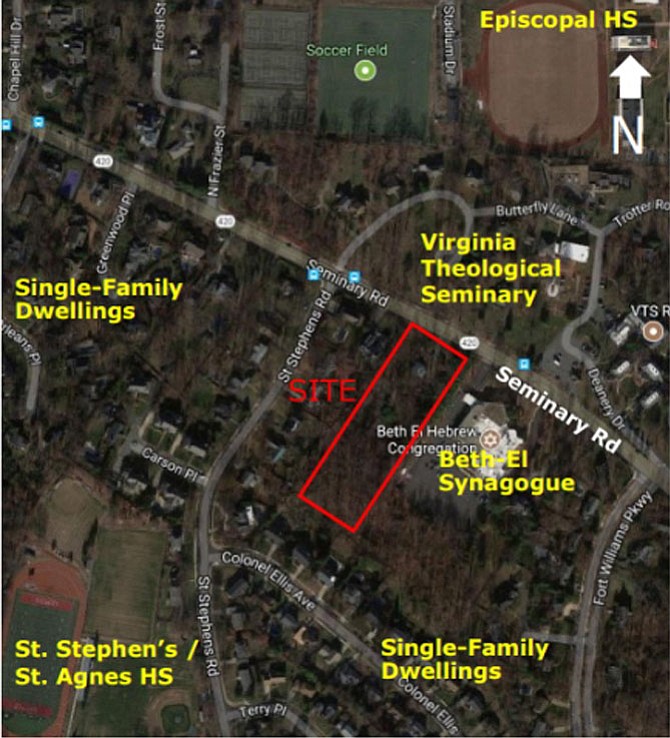“We need to follow the law.” — Councilman Timothy Lovain
After months of battles between neighbors and developers, the battle over Karig Estates finally came to a head as the main topic of discussion in a 10-hour long City Council meeting on Saturday, Jan. 20.
Four homes are planned to be built on a precipice in the Seminary Hill neighborhood. The ground the homes will be built on is saturated with marine clay, a questionably stable foundation, and the homes will be built on a slope over a stream that flows into a protected wetland. However, city staff had reviewed each of the concerns and said the site plans fell within acceptable parameters. On the council, it was a battle between what some saw as common sense and others saw as following the letter of the law.
The legislative procedure also put the council into a particularly tricky situation. The case was an appeal of the Planning Commission’s approval of the project in 2017, which meant it had to be rejected under specific legal grounds about what part of the city code the design violated. City staff and City Attorney Jim Banks repeatedly told the council no such grounds existed.
“We need to follow the law,” said Councilman Timothy Lovain. “This is not a case where we can just substitute our judgment and start over, it has to be legally deficient. We cannot exercise legislative discretion and say ‘you know what, it would be nicer if we did this other thing’ need to address not just the pros and cons and making everybody happy, we have to follow the law. I wish it was different, but we need to honor and follow the law.”
Despite this, there were some on the council who were moved by hours of public testimony warning them of the risks of approving the project.
“I’m here to tell you what will happen to unsuspecting buyers in Seminary Ridge if you let this decision stand,” said Deborah Spagnoli. “I purchased a home [in Seminary Ridge] in 2003, and I was not informed … our home was built on unstable marine clay.”
Spagnoli said after things started going wrong around the house, she tore down the drywall and found a horizontal crack across the foundation that stretched 28 feet.
“Imagine the tears and horror when we found out that marine clay was to blame,” said Spagnoli. “[It was] $50,000 to $150,000 to fix the structural issues. How could something like this happen in a million dollar neighborhood?”
Nina Schwartz, a neighbor downhill from the proposed development, expressed concerns that the development would produce a spike in the amount of groundwater and storm runoff for other homes. In a one-tenth square mile area, Schwartz said a freedom of information act request showed her that 21 homes had to do waterproofing jobs on their home.
In addition to local residential neighbors, members of the nearby Beth El Hebrew Congregation spoke out against the potential environmental impacts of the development. Julienne Bramesco, president of the Beth El Hebrew Congregation, said it was the congregation’s duty as good neighbors to come forward and speak out against the harmful environmental impact of the development.
The opposition to the development was backed by two city experts, Rod Simmons and Tony Fleming. Neither testified at the council meetings, but had previously made public their concerns about the project. Simmons, the city’s resource manager, had said the development would remove valuable canopy trees and compromise the wetlands. Tony Fleming, a geologist and author of the Online Geologic Atlas of the City of Alexandria, warned about the dangers of building the homes on marine clay. Fleming had also said that the water in the ravine behind the homes was an intermittent stream, and therefore legally protected. But the official classification had ruled that it was not protected as part of the stream flows through a pipe..
“Staff is constrained by what we can protect and what we can require developers to protect,” said Karl Moritz, director of Planning and Zoning. “”We cannot require them to protect something we did not previously designate.”
Despite the concerns, advocates for the Karig Estates development said it had followed all of the rules.
“We are a city of laws,” said Mary Catherine Gibbs, an attorney for the developer. “If the plan meets the code, it must be approved. Your staff has already determined that it does meet the code.”
From the legal side, Banks echoed Gibbs’ assessment.
“If you have before you legally sufficient site plan, it is ministerial action,” said Banks. “Under the law, you must approve it. Only way you could not approve this is to find that it is legally deficient in one form or another. Staff has clearly identified grounds that are cited for the appeal and legal standards for which those must be met, concerns outlined are not part of that standard.”
By the end of the public discussion, there were three sets of opinions on the council. At one end, Councilman Paul Smedberg motioned to dismiss the appeal, saying that he trusted city staff’s analysis of the project. On the other end was Silberberg, who said she believed there was room for further compromise on the project if it was remanded back to the Planning Commission. Between them was Councilwoman Redella “Del” Pepper, who said she was very reluctantly forced to vote in favor of the project without a solid legal reason to reject it.
“The whole audience is making recommendations and telling us how to make it better,” said Pepper. “If they’re not responded to, they are going to leave feeling that they were not heard, that we do not care, or that we are just going to rubber stamp this. And there’s reason to believe that, because it seems like there’s not much choice on our part.”
The City Council voted 6-1 for dismissal of the appeal, with Silberberg opposing.

